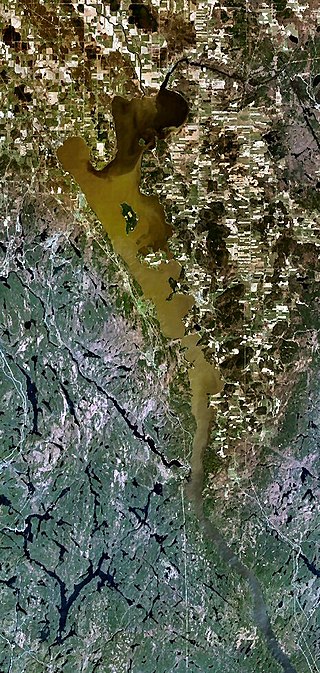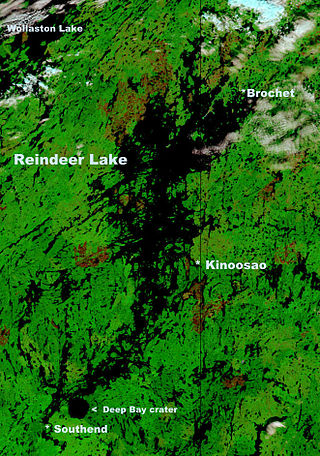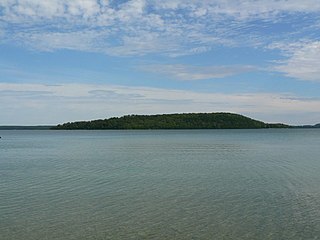
Lake Winnebago is a shallow freshwater lake in the north central United States, located in east central Wisconsin. At 137,700 acres, it is the largest lake entirely within the state, covering an area of about 30 miles by 10 miles with 88 miles of shoreline, an average depth of 15.5 feet, and a maximum depth of 21 feet. It has many shallow reefs along the west shore and a drop-off type shoreline on the east. There are several islands along the west shore.

Lake Nipissing is a lake in the Canadian province of Ontario. It has a surface area of 873.3 km2 (337.2 sq mi), a mean elevation of 196 m (643 ft) above sea level, and is located between the Ottawa River and Georgian Bay. Lake Nipissing is the third-largest lake entirely in Ontario. It is relatively shallow for a large lake, with an average depth of only 4.5 m (15 ft). The shallowness of the lake makes for many sandbars along the lake's irregular shoreline. The lake reaches a maximum depth of 64 m (210 ft) near the mouth of the French River, off the shore of Blueberry Island. The lake has many islands most of which are protected under the Protection of Significant Wetlands scheme, controlled by the Ministry of Natural Resources and Forestry.

Lake Timiskaming or Lake Temiskaming is a large freshwater lake on the provincial boundary between Ontario and Quebec, Canada. The lake, which forms part of the Ottawa River, is 110 kilometres (68 mi) in length and covers an area of almost 295 km2 (114 sq mi). Its water level ranges between 175 m (574 ft) and 179 m (587 ft) above sea-level, with a mean annual average of 178.4 m (585 ft). The lake is in places up to 216 m (709 ft) deep. There are several islands on the lake, notably Mann and du Collège Islands.

Reindeer Lake is a lake in western Canada located on the border between north-eastern Saskatchewan and north-western Manitoba, with the majority in Saskatchewan. The name of the lake appears to be a translation of the Algonquian name. It is the 24th largest lake in the world by area, as well as being the second-largest lake in Saskatchewan and the ninth largest in Canada. 8% of the lake lies in Manitoba and 92% of lake in Saskatchewan.

The Door Peninsula is a peninsula in eastern Wisconsin, separating the southern part of the Green Bay from Lake Michigan. The peninsula includes northern Kewaunee County, northeastern Brown County, and the mainland portion of Door County. It is on the western side of the Niagara Escarpment. Well known for its cherry and apple orchards, the Door Peninsula is a popular tourism destination. With the 1881 completion of the Sturgeon Bay Ship Canal, the northern half of the peninsula became an island.
Loon Lake is a wishbone-shaped body of water in Warren County, New York, USA. It is located within the Town of Chester, which maintains the beach. Fishing and boating are popular activities. Common fish species within the lake include pumpkinseed sunfish, walleye, rock bass, tiger muskie, yellow perch, smallmouth bass, largemouth bass, northern pike, bluegill, common rudd and brown bullhead. The lake has its own marina, where boats may launched and docked for a fee. It is possible to rent speedboats, pontoon boats, canoes and paddle boards. The marina has its own bait and tackle/quick mart. It is open from May to September. The marina is located off the lakes main road, Marina Road.

Gun Lake is a lake in the U.S. state of Michigan, located mostly in Barry County with the southwestern tip extending into Allegan County. Along most of the lake are numerous summer homes, cottages, and permanent residences. The Yankee Springs Recreation Area is based on northeastern portions of the lake. Gun Lake is the location of a State Park with a boat launch, two beaches, a campground, and picnic areas.

Lake Gogebic is the largest natural inland lake of the Upper Peninsula of Michigan. It is located within the one million acre (4,000 km²) Ottawa National Forest. Lake Gogebic State Park is located along its western shore.

Kashwakamak Lake is a freshwater lake in North Frontenac, Frontenac County, Ontario, Canada. It is located east of Cloyne, and southeast of Bon Echo Provincial Park.
Grand Lake is a 5,660-acre (22.9 km2) lake in Presque Isle County in the U.S. state of Michigan. Grand Lake is a substantial lake of approximately 7 miles (11 km) in length and up to 1.5 miles (2.4 km) in width. The lake is on the boundary between Presque Isle Township to the east and Krakow Township to the west, approximately 15 miles (24 km) north of Alpena on U.S. Highway 23, which passes to the south and west of the lake.

Lake of Bays is a large lake in the District Municipality of Muskoka in Central Ontario, Canada. It is located almost entirely in the Township municipality of Lake of Bays, which is named after the lake, with the exception of the southwest arm of the lake which is in the Town of Huntsville. Ontario Highway 35 runs north and east of the lake.

Lake Mindemoya is a lake in Ontario, Canada, located within Manitoulin Island which is the world's largest island in a freshwater lake. The lake is located near the town of Mindemoya, and it is the third largest on Manitoulin Island. It has a perimeter of 33.5 km, its marl clay base imparting to a deep blue to light green colour. The lake reaches depths of 21 m (69'), while the average depth is 7.3 m (24'); the surface area is 3,869 ha.
Greenwood Reservoir is a large, 1,073-acre (4.34 km2) impoundment located in Michigan's Upper Peninsula. It is a very picturesque and relatively secluded.
Lake Iroquois is a freshwater reservoir located in west Loda, Illinois in Iroquois County, 13.6 miles (21.9 km) from Onarga. The lake is 20–50 ft from Bayles Lake, the two lakes are separated by a road on the north side of Bayles Lake.
There are three Manistique Lakes in the Upper Peninsula of Michigan. The lakes include North Manistique Lake, Big Manistique Lake, and South Manistique Lake. The towns surrounding the lakes are Curtis, Germfask, and Helmer. The lakes are known for vacationing and fishing. They are also in close proximity to other natural sights such as the Great Lakes, rivers, and smaller lakes as well as tourist attractions including the Canada–US border, the Soo Locks, Mackinac Island, parks, and museums.
Lake Bonaparte is located in Lewis County, New York named after Joseph Bonaparte of the House of Bonaparte. The lake has many different species of fish, and is stocked regularly by the NYSDEC.
Colton Flow is a lake located on the Raquette River at Colton, New York. Fish species present in the reservoir are smallmouth bass, northern pike, rock bass, yellow perch, black bullhead, and walleye. There is a boat launch located on Gulf Road.
Norwood Lake is a man-made lake located by Norwood, New York. Fish species present in the reservoir are smallmouth bass, northern pike, rock bass, yellow perch, and walleye. There is a carry down boat launch located on Riverside Road.
Lewey Lake is a lake located southwest of Indian Lake. Fish species present in the lake are lake trout, lake whitefish, northern pike, smallmouth bass, yellow perch, rock bass, white sucker, and black bullhead. There is a boat launch with a fee in Lewey Lake Campground, on the northeast shore off NY-30.

Long Lake is a 295-acre (119 ha) lake in northeastern Montmorency County, Michigan. The lake is primarily in Montmorency Township, although the southernmost portion is located in Hillman Township, as well as part of the Mackinaw State Forest. The nearest town is Hillman at about 6 miles (9.7 km) southeast of the lake.












